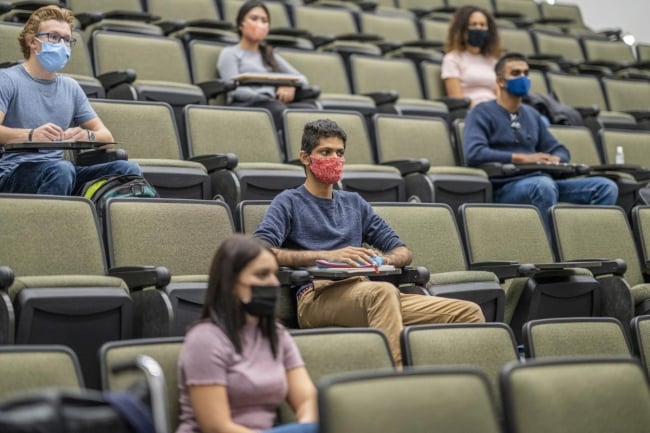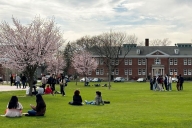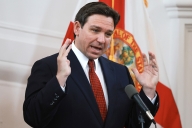You have /5 articles left.
Sign up for a free account or log in.

Fat Camera/E+/Getty Images
Administrators at Lane Community College in Eugene, Ore., steeled themselves for an enrollment decrease this fall after the college lost 1,254 students -- 14 percent of the student body -- in fall 2020 compared to the previous year. They predicted a smaller decline of about 2 percent this quarter, but the drop was much deeper. The student head count plummeted by about 20 percent this fall, to 6,065 students from 7,664 in fall 2020.
Over the course of the pandemic, the college has lost about a third of its student body.
“It’s going to take time to recover from that,” said Paul Jarrell, provost and executive vice president of the college. “It will take us several years to build back the enrollments we lost in the last two years.”
The college now has about $3 million less in tuition revenues than expected in a typical year. Tuition accounts for half of the college’s overall funding; the transition to online courses and lost revenues meant about 300 part-time employees and student workers had to be let go in spring 2020 and vacant positions were not filled, according to KLCC, the local public radio station in Eugene.
Jarrell expects the downward trend to continue until the college can return to offering half its classes in person next quarter. About 80 percent of the college’s courses are currently online because of a surge in the highly infectious Delta variant of the coronavirus in the county. He said students told college leaders in student forums last year that they were unenthused about another quarter of remote learning. He worries students who left won’t come back next quarter.
“The longer students stay out of school, the less likely they are to return,” Jarrell said. “My biggest fear is the lost opportunities for students and how permanent that might be.”
His concerns about the future of the college and its students are all too familiar for many community college leaders across the country, whose institutions are also experiencing enrollment declines again this fall after steep drop-offs last year. Community college enrollment fell roughly by 10 percent nationally -- a loss of over 544,200 students -- in fall 2020 compared to fall 2019, according to data from the National Student Clearinghouse Research Center.
Spring 2021 semester enrollment numbers were comparably worrying. They fell by 9.5 percent compared to spring 2020. These pandemic-related losses come after about a decade of enrollment declines at community colleges, and in some geographic areas, decreasing populations of traditional college-age residents.
“What we are seeing is it’s kind of all over the place in terms of enrollment -- some up, some down, some level,” said Jee Hang Lee, senior vice president at the Association of Community College Trustees.
Steven Gonzales, interim chancellor of the Maricopa County Community College District, was also “really surprised” by the most recent dip in enrollment at the district’s 10 colleges. The number of students enrolled in credit-bearing courses fell by 15 percent in 2020, to 103,853 from 122,392 in 2019, and head count dropped by about 4 percent from fall 2020 to fall 2021.
The decline in students last year forced the district to reduce its operating budget by 3 percent.
“We’re going to need to dig out of this hole that we’re in,” Gonzales said. “Otherwise, we’re going to be faced with some tough decisions.”
Jarrell said administrators at Lane Community College are working on new enrollment strategies but also recognize the need for a shift in approach to become a "leaner, more efficient" college. They’re asking themselves, if low enrollment persists for several years, "How do we become a smaller college?"
They’re also wondering about larger economic repercussions beyond the campus.
"While the impact is huge to our campuses, the impact is even greater to the communities that the campuses serve," Jarrell said. "Community colleges are seen as that socioeconomic engine for a community," and the harder it is for colleges to operate, "the less of an engine we can be."
To be sure, not all community colleges are suffering declines. Some are experiencing enrollment upticks. For example, three out of 15 colleges in the Mississippi Community College System -- Northeast Mississippi, East Mississippi and Mississippi Delta Community Colleges -- saw enrollment increases. However, they are the exceptions and not the norm. Jarrell believes the majority of community colleges are still "hurting."
Adenuga Atewologun, president of Riverland Community College in Minnesota, is focused on the financial ramifications for community colleges still experiencing enrollment declines.
“If you can’t build your enrollment back, then you have to downsize staff … instruction and support services,” Atewologun said. “It’s very important for us right now to start finding ways to build enrollment back. Otherwise, an institution like ours, and many institutions across the country, will find themselves in a downward spiral.”
Unlike many of its peer institutions, the rural college in Minnesota saw an increase in enrollment between the 2019 and 2020 fiscal years, but student head count dropped by about 11 percent this fall so far compared to the previous fall. The college usually attracts a significant number of international students because it offers on-campus housing. International students generally make up about 10 percent of the student body, but those numbers dwindled during the pandemic.
Atewologun said the approximately $69 billion in federal COVID-19 relief funds doled out to higher education institutions, including community colleges, was a much-needed temporary relief for the sector, and the money helped his college stave off budget cuts. But he believes the real test will be when the relief funds stop flowing next year.
“One-time money does not bode well for us for long-term financial sustainability,” he said.
Lee said community colleges that used COVID-19 relief funds to clear balances owed by students could see positive effects on their enrollments.
Dustin Weeden, senior policy analyst for the State Higher Education Executive Officers Association, said luckily for community colleges, state appropriations have “steadily been going up nationally,” though appropriations are still below levels of a decade ago.
A report by the association found that state appropriations per full-time student increased for an eighth consecutive year in fiscal year 2020. A year of budget slashing followed, with 13 states lowering higher education appropriations by a net total of $417.5 million in fiscal year 2021, according to a report from the National Association of State Budget Officers. This year, states appear to be reupping their investments in higher education as their revenues recover from the pandemic, with notable funding increases in California, Kansas, Missouri and other states.
“What is going to be the line where state legislatures start saying, ‘OK, we keep giving you more money, but your enrollments are going down. Why do you continue to need more money?’” Weeden said.
He noted that colleges in states with performance-based funding formulas, which take enrollment levels into account, among other factors to inform budget recommendations, could find themselves having to drastically improve graduation rates to make up for lost revenue from enrollment declines.
Community colleges resorted to a range of incentives to lure students back to campuses this fall. Institutions loaned students laptops and Wi-Fi hotspots, launched sweeping marketing campaigns, and offered a range of freebies -- including free courses and textbooks, tuition discounts, and even cash payments -- to alleviate students’ financial burdens and encourage enrollment.
The Maricopa district capped tuition at $1,020 per semester for Arizona residents last fall and spring so students could enroll in up to 21.5 course credits for the price of 12 credits. It didn’t work. Low-income and first-generation students still struggled to balance supporting their families during the pandemic and paying for college. The flat tuition rate made less of a dent than Gonzales hoped.
“We thought that might help entice students to not only come to us but take a stronger load,” he said. “It really didn’t have a significant impact on our students.”
Andrew Bowne, president of Johnson County Community College in Kansas, pointed out that low unemployment rates are also a factor pushing students to choose between taking available jobs or spending time and money on college. The unemployment rate has hovered around 3 percent in Kansas.
He noted that enrollment has been decreasing at many community colleges for years prior to the pandemic and declined by more than 20 percent at his college over the last five years.
“For community colleges, we are historically countercyclical to the economy,” he said. “When the economy is strong, enrollment drops off. When the economy is struggling, enrollment grows. Folks are working -- they’re working a lot -- and finding time to go to college became less of an immediate priority.”
Rural and urban institutions are facing different challenges related to their enrollment declines this fall.
Gonzales said urban colleges are competing with for-profit colleges for the same students.
Atewologun said demographic shifts mean fewer high school students are graduating and going to college in some states, and young people in rural areas are moving to less remote places with more job opportunities. And as older workers retire, there aren’t enough graduates entering the local labor market to sustain local industries. These dynamics pose an existential threat to rural colleges.
"For rural colleges, it’s a question of, in my mind, survival," he said.
Despite the changing enrollment landscape, community college leaders largely seem hopeful that students will return, provided institutions offer the supports students need to enroll -- and stay enrolled.
"There’s a lot of work for us to do as a sector around these needs, but I think we’re hopeful that numbers rebound once the pandemic is over," Atewologun said. "Of course, I don’t have an end date for that one yet."









